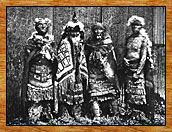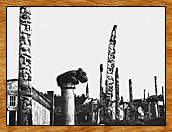 
(Page 3 of 3) |
Masset (cont.)
A few days after arriving in Masset, Collison wrote down an eye-witness account of an important event, a peace ceremony:
The following day Edenshaw, an influential chief, arrived from Virago Sound . . . He and his men were received with honours, and a dance of peace was accorded them. There had been a quarrel between the two tribes, and Edenshaw with his leading men had been invited for the purpose of making peace. As their large canoes approached the shore the occupants chanted the brave deeds of the past, and were answered in a similar strain by the concourse of the shore. The chanting was accompanied by regular and graceful motions of the head and body and waving of the hands. The time was kept by a large drum formed like a chest, and made of red cedar wood, painted with grotesque figures, and covered with skin. This was beaten by a drummer seated in the bow of the leading canoe. Naked slaves with their bodies blackened, each bearing a large copper shield, now rushed into the water and cast the shields into the deep, in front of the canoes of the visitors. As these shields are made of native copper, and inscribed with their crests, they are highly valued among the Indians, consequently this was one of the highest marks of welcome and honour. Not that the copper shields were lost to the owners, as they were recovered afterwards on the ebb of the tide.
On landing, the visitors were preceded by a number of dancers, male and female, specially arrayed and with faces painted, who led the way to the lodge prepared for their reception. The central seat was given to Edenshaw, and his leading men were seated around. A messenger now entered to announce the coming of his chief and party to welcome his guests. These at once entered, the chief preceding and followed by the sub- chiefs, and principal men in their dancing attire. The headdress or shikid bore the crest of the tribe on the front inlaid with mother-of-pearl, and surmounted by a circlet or crown formed of the bristles of the sea lion, standing closely together so as to form a receptacle. This was filled with swan or eagle's down, very fine and specially prepared. As the procession danced around in front of the guests chanting the song of peace, the chief bowed before each of his visitors. As he did so, a cloud of the swan's-down descended in a shower over his guest. Passing on, this was repeated before each, and thus peace was made and sealed.
The strongest opposition to the missionary came from the shaman, who realized the threat he posed to their traditional practices. Foremost among them was Dr. Kudé, who was a chief as well as a shaman and who owned a most impressive house in the back row of Masset. Dr. Kudé seems to have continued his power struggle with Collison's successor for the Church Missionary Society, for according to Reverend Charles Harrison, who took up his charge in 1882, "he endeavored to persuade the people that the medicine of the Europeans was inevitably fatal to an Indian unless its effect was eradicated by a course of treatment also at his hands." Harrison's description of Kudé agrees with photos of the shaman:
Kudé, the Masset Shaman, had long tangled hair -- it well nigh reached his knees--but when not viably engaged he kept it tied up on top of his head and secured by beautifully carved bone pins. This long hair was believed to assist in his magical power over the evil spirits.
Kudé was finally convinced to cut his hair and become a Christian. He handed over his charms and rattles to Reverend Harrison, who deposited them in the Pitt Rivers Museum at Oxford University.

 |
Dr. Kudé (second from left) and other shaman of Masset pose for a photograph. Kudé wears the Chilkat blanket of a chief, a title that he had claim to, rather than the dance apron of a shaman. The figure on the left wearing the mask with a crooked mouth represents the wife of one of the other masked figures who was supposed to be dead; Dr. Kudé has just restored him to life. The man on the right displays a Bear tattoo on his chest and upper arms, and a Whale tattoo on his forearm. This is the only known photo of Haida shaman wearing masks.
Photograph by Edward Dossetter, 1881. |

Albert Edward Edenshaw moved permanently to Masset after old Chief Wiah died in the autumn of 1883. The new chief, Henry Wiah, was neither as wealthy nor as powerful as his predecessor but was well liked by the villagers and welcomed Edenshaw to his town. One of the most significant changes in Masset was the resettlement there of the survivors from all of the other north coast villages after 1883, when Chief Henry Wiah called for old differences to be set aside. People also had a growing desire to live in a community with schools and a mission, as well as a degree of health care (including inoculation against smallpox), which missionaries dispensed along with the gospel.
In 1883, Albert Edward Edenshaw inherited a house at Masset from a cousin and, according to Charles F. Newcombe, lived there until his death. A memorial pole that appears to have been erected shortly after he moved into the house has his crests of the Raven and Beaver. The central interior pole also displays his crests, the Raven with frogs in its ears on a Bear, but it may have been installed by his cousin when the house was built; it is now in the Field Museum in Chicago.
Albert Edward Edenshaw appears in almost every traveller's account until his death in 1894. Although he had been suspected of complicity in old Chief Wiah's capture of the Susan Sturgis in 1852, Edenshaw's decisive action was acknowledged by the captain with saving his and the crew's lives. Edenshaw successfully negotiated their release in return for a ransom from the Hudson's Bay Company at Fort Simpson, and a marble memorial to this feat was erected in front of Henry Edenshaw's Property House in the middle of Masset. Albert Edward also owned a house at Klinkwan village in Alaska, and his house in Masset had a fine frontal pole and a memorial post topped with a huge figure of a Bear, similar to the figure of a Bear in Kiusta. His nephew Charles Edenshaw, the famous carver, later resided in this house and may have placed the name board "Edenshaw" over the door to advertise his art works for sale to travellers. In the late 1890s, the dwelling was replaced by the modest frame house where Charles Edenshaw lived until his death in 1924.

 |
The central area of Masset, including the house that Charles Edenshaw inherited and later replaced with a European-style building. He had already begun to advertise his artwork when this photograph was taken.
Photograph by Stephen Allen Spencer, circa 1880. |

|